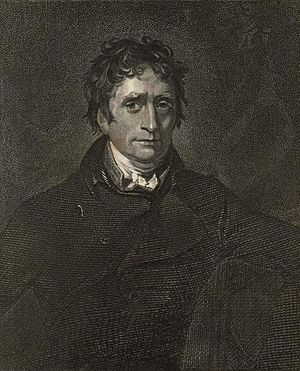Thomas Erskine, 9th Earl of Kellie facts for kids
Thomas Erskine, the 9th Earl of Kellie (born around 1746 – died February 6, 1828), was a Scottish businessman, landowner, and politician. For many years, he lived in the Swedish port city of Gothenburg. He returned to Scotland in 1799. This was when he inherited the title of Earl of Kellie from his nephew, Charles Erskine, the 8th Earl. He then became the 9th Earl of Kellie.
A Scottish Nobleman's Journey
Thomas Erskine was born in Scotland into a noble family. His family had lost much of their wealth. This was because they had supported the Stuart royal family in the past. He was likely born at Cambo House in Fife, which was one of the family's properties that had been taken away.
Life in Gothenburg
When he was young, Thomas was sent to Gothenburg to learn about business. In 1759, he started working for George Carnegie. Carnegie was a Scottish person living in exile who had become a merchant there. After a few years, Thomas moved to a company owned by the English Hall brothers. They exported iron. In 1767, he became a partner in their company.
Over 30 years as a partner, he earned a lot of money. Besides his work with the Hall brothers, Erskine also ran his own business. Later, he partnered with David Mitchell. Mitchell took over Thomas Erskine & Co. when Erskine left for Scotland.
In 1775, Erskine became the British consul for Gothenburg. He also covered Marstrand and other port cities on Sweden's west coast. As consul, he sent regular reports to the British government. These reports included information about Sweden's illegal trade with France during the revolutionary wars. This job also helped him gain a higher social standing in Gothenburg.
He was one of the 20 founding members of the Royal Bachelors' Club. This club was like an English gentlemen's club. It started in 1769. Its main purpose was to get around a rule that banned playing billiards in public places.
Returning to Scotland
Erskine bought back Cambo House in 1790. He spent the winter of 1793–94 in Scotland. However, he went back to Gothenburg. He stayed there as consul and continued his business until 1799. In that year, he inherited the Earldom of Kellie from his nephew, Charles Erskine.
His final move to Scotland was a bit difficult. The Gothenburg City Council wanted him to pay a large part of his wealth before he left Sweden.
As the Earl of Kellie, Erskine was chosen to be a representative Scottish peer in the British House of Lords in 1804. He was chosen again in 1807. He remained a member until he died. In 1824, he became the Lord Lieutenant of Fife. This was a special role representing the King in the area of Fife.
Family and Legacy
In 1771, Thomas Erskine married Anne Gordon. She was the daughter of Captain Adam Gordon. They did not have any children together. However, Erskine had a daughter named Harriet (born in 1763) from before his marriage. Harriet married Johan Henrik Engelhart, a medicine professor. Four of Harriet's children were raised in their grandfather's home in Scotland.
The earldom was passed down to Erskine's brother, Methven. But a new noble title, the Erskine Baronetcy, was given in 1820 to the 9th Earl's grandson, David Engelhart. David changed his name to Erskine. Thomas Erskine made sure that the Cambo estate would go to David. David's sister, Harriet Engelhart, married a cousin, another David Erskine. He settled as a merchant in Stockholm.


